#Louise Anne de Bourbon
Text

Portrait of Anne of Austria (1601-1666), wife of Louis XIII of France.
It’s probably a depiction of Anne Marie Louise d'Orléans (1627-1693), granddaughter of Henry IV of France. Circle of Charles Beaubrun.
#royaume de france#maison de bourbon#anne d'autriche#reine de france#vive la reine#anne marie louise d'orléans#duchesse de montpensier#la grande mademoiselle#maison d'orléans#bourbon orleans#charles beaubrun
4 notes
·
View notes
Photo

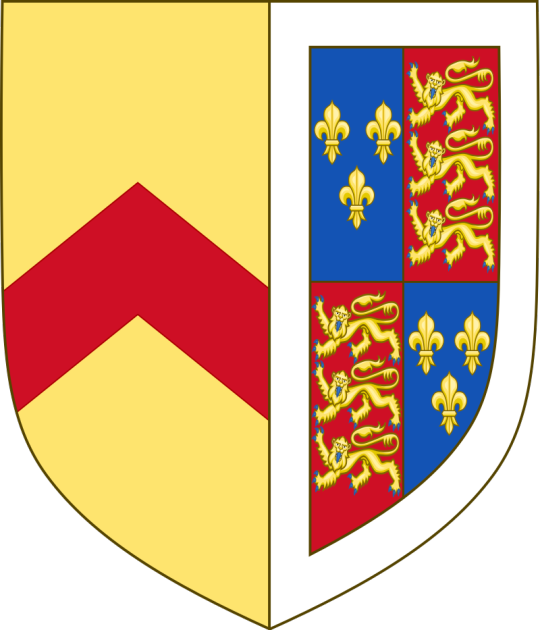

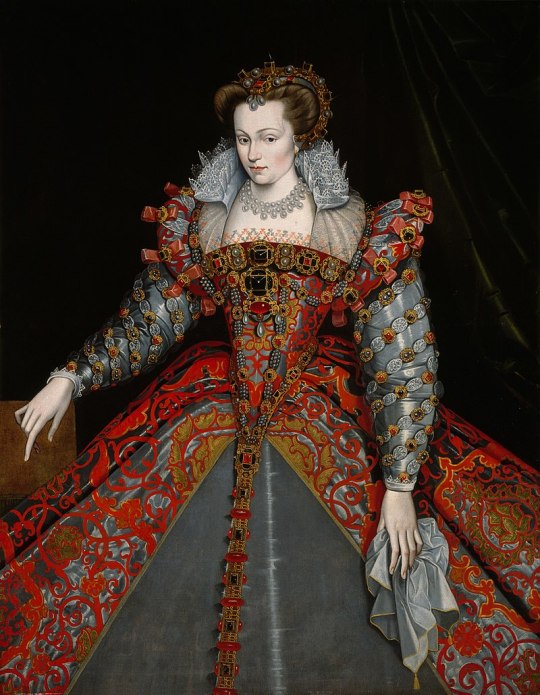
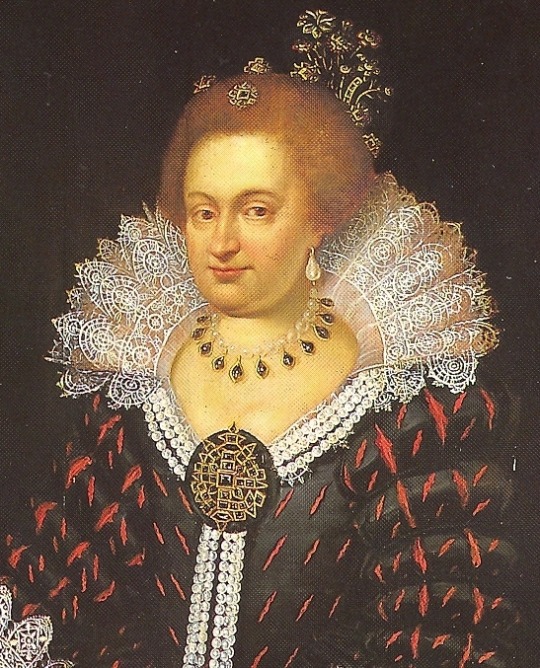

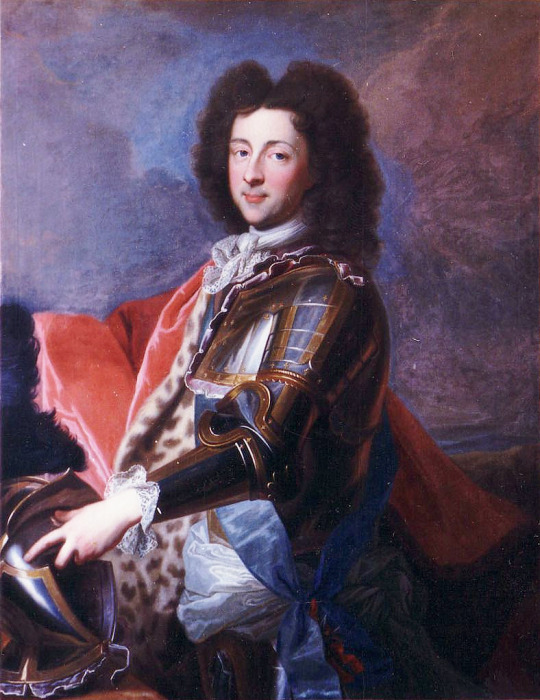
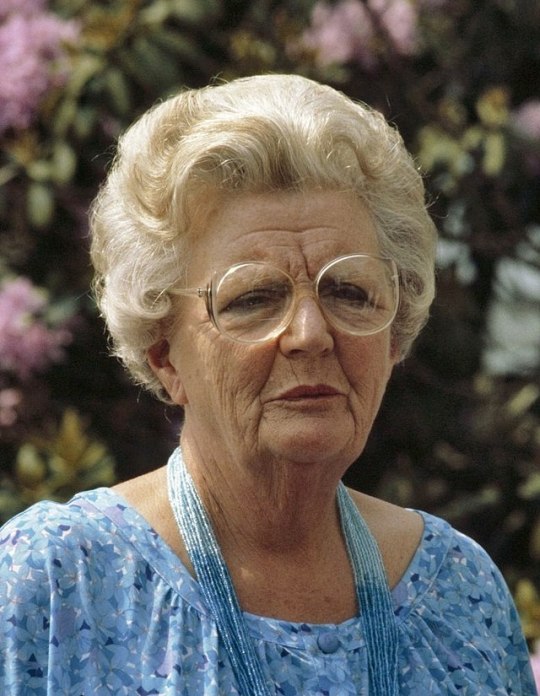


Royal Birthdays for today, April 30th:
Casimir III, King of Poland, 1310
Anne of Gloucester, Countess of Stafford, 1383
William III, Landgrave of Thuringia, 1425
Louise of Lorraine, Queen of France, 1553
Éléonore de Bourbon, Princess of Orange, 1587
Mary II, Queen of England, 1662
François Louis, Prince of Conti, 1664
Juliana, Queen of the Netherlands, 1909
Carl XVI Gustaf, King of Sweden, 1946
Miguel Urdangarín y de Borbón, Son of Infanta Cristina, 2002
#mary ii#louise of lorraine#casimir iii#Éléonore de Bourbon#william iii#anne of gloucester#francois louis de bourbon#queen juliana#carl xvi gustaf#Miguel Urdangarín y de Borbón#long live the queue#royal birthdays
18 notes
·
View notes
Text
Louise Bourgeois (Louise Boursier), 1563-1636
Midwife to Queen Marie de Médicis, renowned author of medical textbooks translated into many languages

Born in Paris, Louise Bourgeois in 1584 married the king’s surgeon Martin Boursier, with whom she had five children. She led a very happy life. But during the Religious Wars, the Boursier family was forced to leave Paris and find refuge in Tours, where they suffered a life of financial difficulties. Returning to Paris, Louise Boursier became a midwife to provide financial assistance to her family. In spite of opposition from within the profession, she practiced for five years among the poor and became a registered midwife in 1598. This period of her life is recounted at the beginning of her Recit veritable de la naissance de messeigneurs etdames les enfans de France (True Account of the Birth of the Sons and Daughters of France).
In 1601, a wonderful opportunity was offered to Louise Boursier: Queen Marie de Médicis was looking for a midwife. Demonstrating a strong sense of authority and loyalty, Louise Boursier was chosen by the queen to deliver her six children between 1601 and 1610 (the year King Henry IV was assassinated). Louise Boursier was well respected and became the most popular midwife at the court.In 1627, however, Marie de Bourbon Montpensier gave birth to her daughter, Anne-Marie-Louise d’Orléans (La Grande Mademoiselle),and died suddenly of a puerperal fever. Her midwife, Louise Boursier, was accused of negligence by the physicians who did the autopsy. Her popularity began to decline, and she spent the rest of her life writing and publishing very successful books about her art until her death in 1636. Her famous works were read all over Europe. First published in 1609, her Observations diverses, sur la stérilité, perte de fruict, foecondité, accouchements, et maladies des femmes, et enfants nouveaux naiz (Various Observations on Sterility, Miscarriage, Ability to Conceive, Childbirth, Female Illnesses,and Infants) provides scientific remarks on obstetrics and numerous guidelines for the care of the pregnant woman as well as her infant. Becoming the manual of reference, this book was augmented and published again and again (in 1617, 1626, 1634, 1642, and 1652). It was also translated into Latin, German, Dutch, and English, underscoring the importance of her European reputation at that time. Some parts of her works are of particular interest: Recueil des Secrets, de Louyse Bourgeois dite Boursier (Book of Secrets of Louise Bourgeois Boursier), published just before she died (1635), is a compilation of recipes for women for the treatment of ailments such as skin eruptions, painful periods, and the like.The most interesting writings of Louise Boursier are the Récit véritable (True Account) and the Instruction à ma fille (Advice to my Daughter), both published in 1617, where she presents her short autobiography as well as the spiritual testament of an exemplary midwife.
In her own time, the well-educated and highly competent Louise Boursier was something of an anomaly, first among her male coworkers, who came to resent her as she became a self-confident practitioner, and also among other sworn midwives who saw her as a formidable challenger to their own preeminence in the field because of her marriage to a surgeon and her unusual training (Louise had studied Ambroise Paré’s book on obstetrics). Furthermore, important changes were taking place in the medical and surgical professions. For centuries, women, having gained their skills from experience, monopolized midwifery. With the upsurge of medical science in the sixteenth century, physicians became more interested in the art of delivery, and, as organized instruction and licensing became prevalent, these requirements extended also to women engaged in midwifery.
In a time of growing suspicion over women’s capacities to handle child delivery, Louise Boursier understood the need for formal training and collaboration with male physicians and surgeons. She saw herself as the founder of a new generation of midwives, more knowledgeable and better trained. In her effort to educate those who would follow her, she published Instruction à ma fille, the first treatise in French on the art of midwifery. She recorded her theories on maternity care and her experiences in Parisian society in her Récit veritable. This important work provides a unique source of information about midwifery practices in the early modern period as well as insights into the challenges women faced as they entered the professional world.
Colette H. Winn, in Encyclopedia of Women in the Renaissance
#xvi#xvii#louise bourgeois#louise boursier#midwifery#marie de médicis#ambroise paré#marie de bourbon-montpensier#anne-marie-louise d'orléans#la grande mademoiselle#encyclopedia of women in the renaissance#colette h. winn
10 notes
·
View notes
Photo


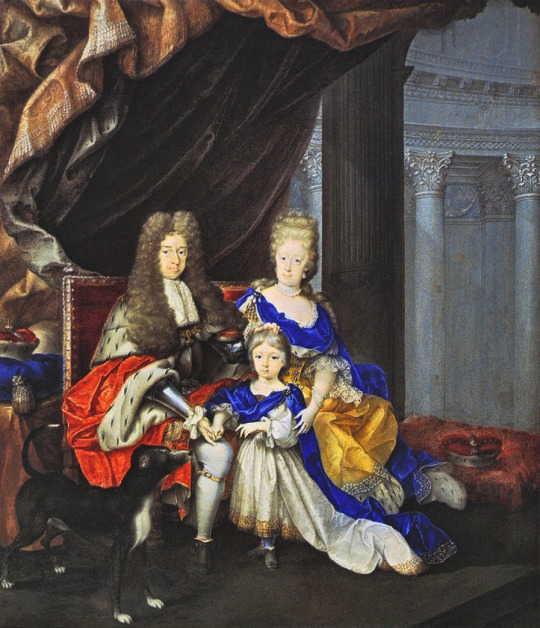
Late Louis XIV style (from top to bottom) -
Anne Louise Bénédicte de Bourbon 1676-1753 ("Elisabeth-Charlotte de Bavière") by François de Troy (Sotheby's - 26Jan12 auction Lot 213). Cropped & erased most obvious spots & cracks w Pshop 2880X3757 @72 3.9Mj. Sometimes called Liselotte of the Palatinate.
1690s Gentlewoman by Antonio Franchi (Palazzo Pitti - Firenze, Toscana, Italy). From tumblr.com-blog-view-history-of-fashion; erased spots w Pshop & filled shadows 40% 1541X1946 @150 1.1Mj.
ca. 1696 Maximilian II Emanuel of Bavaria, Maria Antonia of Austria, & son Joseph Ferdinand (b. 1692) by F. C. Bruni (Der Residenz - München, Bayern, Germany). From tumblr.com/blog/view/catherinedefrance; erased spots w Pshop.
#late Baroque style#late Louis XIV style#1690s fashion#Anne Louise Bénédicte de Bourbon#François de Troy#fripon curls#wrapper#fur-trimmed wrapper#robes#Antonio Franchi#curly hair#lace-edged chemise#Maximilian II Emanuel of Bavaria#Maria Antonia of Austria#F. C. Bruni#scoop neckline#elbow-length sleeves
3 notes
·
View notes
Text



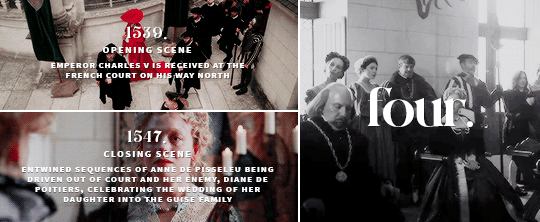
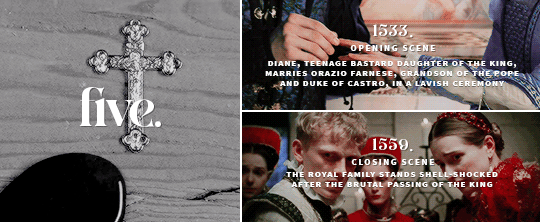


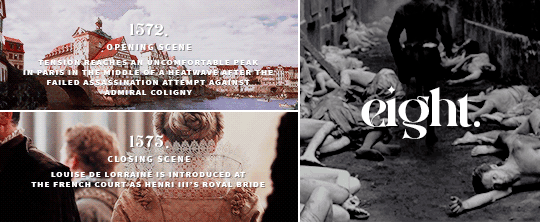
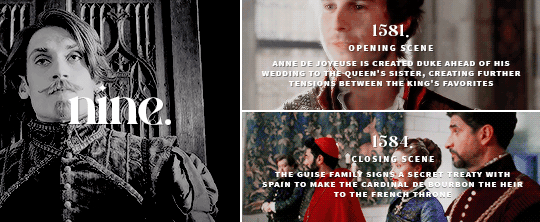


K I N G S I D E, a tale of seven kings
first season 1514-1520. Claude and François finally get married, a vacant seat for Mary Tudor, Louise of Savoy's stubborness to keep her son in check. A new King arises, the New Order, François' quest for glory in Italy. Another crown, another campaign.
second season 1522-1530. The inheritance dispute that leads Bourbon to treason. The pursuit of the italian dream, Claude dies, all is lost in Pavia. Süleyman and the unthinkable alliance, captivity in Spain. The Ottoman fleet. Royal depression. The inheritance dispute that led Bourbon to treason. The ladies' peace, Henry VIII flinching, a price for two princes, a New wife for the King.
third season 1531-1537. Louise dies, tensions between François and Marguerite. The wedding of Catherine and Henri. The rise of Pisseleu, the battle at Court between Charles and Henri and their people. War between Diane and Montmorency. Placards and the anti-heterics frenzy, another war in Italy. Wedding and death of Madeleine.
fourth season 1539-1547. Mending tensions between France and Spain. A very stubborn niece. All eyes on Henri and Catherine's sterile womb. Death of Charles. The duel in Jarnac. The King is dead, long live. Diane de Poitier's absolute triumph over Anne de Pisseleu. The Guises make their move.
fifth season 1553-1559. Diane of France's not so typical royal wedding. Catherine giving birth to the twins, Chenonceau goes to Diane, the cordial hate between the two. Rohan VS Nemours. Montmorency mess and a remarriage for Diane of France. The death of Henri, everything falls down.
sixth season 1560-1564. François II barely hanging on, Catherine's almost giving up, Elisabeth married off, the Guise family's counterpower, Montemorency's political exile, the Amboise conspiracy, preparations for the grand tour.
seventh season 1565-1572. The end of the grand tour, encounter between the royal family and Elisabeth, queen of Spain. The rise of Charles IX, a new queen, Marie Touchet and her bastard boys. Catherine's plans to get a match for Marguerite. Rising tensions between Charles and Henri after Jarnac and Montcontour. Marguerite's nuptials amidst tensions and Coligny's attempted murder.
eighth season 1572-1575. Coligny and the Protestant leaders rallying the troops. The Saint Barthelemew Massacre and the promise of Marguerite to never forgive her family. Catherine finds out Anjou's possible involvement. A new king for Poland. Marguerite's toubled married life. Death of Charles IX. Henri's escape from Poland and slow return to France.
nineth season 1581-1584. Catherine's illusions shatter. New King, no heir. Marguerite returns to Paris. Louise shows some spine against the King's favorites. Quarelling with Anjou, tensions with Elizabethan England, Anjou's election and subsequent death and Catherine's anger. The Guise family veering off the road.
tenth season 1585-1589. The mounting war of the three Henris. All eyes on King Henri who has no sons, Catherine's political exile, the slow burning of the last Valois children. Hunting down Marguerite from stronghold to stronghold, ending with her house arrest in Usson. Assassination of the Guise brothers, the death of Catherine, Henri III breaks down in Diane's arms. Marguerite in exile, Diane the only "true" daughter of Catherine's, as she sets out to (successfully) pacify the kingdom on her own.
#historyedit#perioddramaedit#mine#*#*kingside#16th century#so yeah this took me a whole month instead of a good week#we love crappy laptops
156 notes
·
View notes
Text
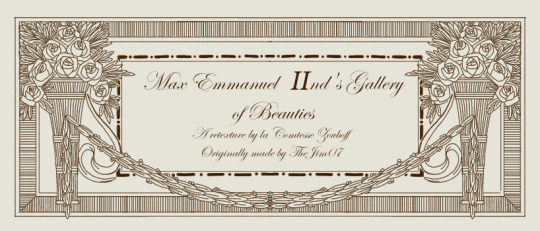




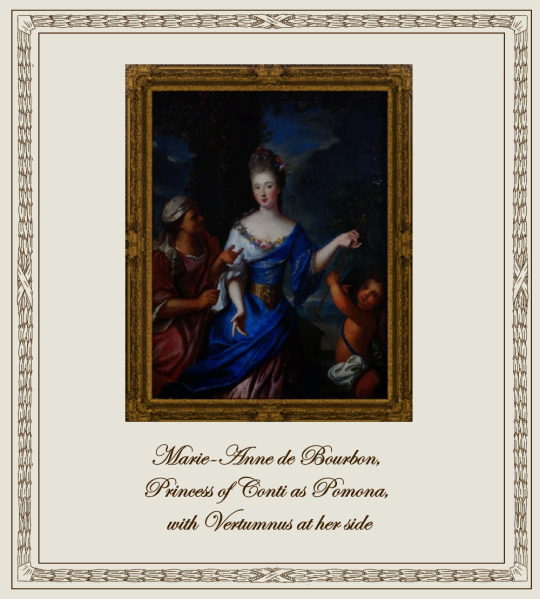

Max Emmanuel II's Gallery of Beauties
A retexture by La Comtesse Zouboff — Original Mesh by @thejim07
Elector Max Emanuel’s Great Gallery of Beauties shows five portraits of ladies at the court of Louis XIV, painted by Pierre Gobert around 1715, brought from the Palace of Versailles, these paintings displayed ladies and princesses of the french court at the dawn of Louis XIV's life.
This set contains 5 portraits, with the original frame swatches, fully recolourable. The portraits are of:
Marie-Anne de Clermont, Duchess of Joyeuse with a dog.
Marie Anne de Bourbon-Conti, Princess of Conti as Venus with Cupid
Marie Louise Élisabeth d'Orléans, Duchess of Berry
Louise Françoise de Crussol d'Úzès, Marquise of Gondrin as venus with cupid
Marie-Anne de Bourbon, Princess of Conti as Pomona, with Vertumnus at her side (replacing the portrait of Madame de Charolois, as no decent pictures of the portrait exists)
Found under decor > paintings for 2.090§
Retextured from the "Portrait of the Duchess of Angoulême" found here
-------------------------------------------------------
CC shown here:
Wall paneling and floor by @thejim07
Loveseat, armchairs and chairs by @aroundthesims
Doors by @joojconverts

Drive
(Sims3Pack | Package)
(Useful tags below)
@joojconverts @ts3history @ts3historicalccfinds @deniisu-sims @katsujiiccfinds
-------------------------------------------------------
#the sims 3#ts3#sims 3 cc#s3cc#sims 3#sims 3 download#portrait#sims 3 decor#sims 3 art#nymphenburg#louis xiv#palace of versailles#pierre gobert#wall decor
32 notes
·
View notes
Text
Day 7: Charlotte of Savoy
Charlotte of Savoy
Born: c. 1441/3
Died: 1 December 1483
Parents: Louis, Duke of Savoy and Anne of Cyprus
Queen of France
Children: Louis (18 October 1458 – 1460)
Joachim (15 July 1459 – 29 November 1459)
Louise (born and died in 1460)
Anne (3 April 1461 − 14 November 1522) - the wife of Peter II, Duke of Bourbon
Joan (23 April 1464 – 4 February 1505) - the wife of Louis XII, King of France
Louis (born and died on 4 December 1466)
Charles VIII of France (30 June 1470 – 8 April 1498)
Francis, Duke of Berry (3 September 1472 – November 1473)
Charlotte of Savoy was one of the 19 children of Louis, Duke of Savoy and Anne of Cyprus.
On 11 March 1443, the one year old Charlotte was betrothed to Frederick of Saxony, son of Frederick II, Elector of Saxony, but the arrangement was annulled for unknown reasons.
Almost 8 years later, on 14 February 1451, Charlotte married Louis, Dauphin of France,eldest son of Charles VII of France and Marie of Anjou.
Charlotte was 9 years old and Louis was 27.
Louis' previous wife died childless in 1445.
The marriage took place without the King of France’s consent.
Upon the wedding, Charlotte became Dauphine of France.
When Louis received news of his succession to the throne of France, he abandoned Charlotte at the Burgundian court.
On 22 July 1461 Charlotte became the Queen of France.
Soon she became ill and was close to death by August 1462. She recovered but despite that her health remained weakened.
Louis XI kept his wife away from court at the Château of Amboise along with her household.
Charlotte mostly spent her days with her sisters and courtiers, playing chess, marbles, doing needlework, praying, doing her religious duties and supervising her daughters' education.
On very few occasions, she was asked to perform her ceremonial duties as queen such as greeting foreign dignitaries.
Charlotte served as regent of France in September 1465.
Louis died on 30 August 1483 and was succeeded by their son Charles VIII.
He did not appoint a regent instead left instructions for a royal council to govern during the minority of Charles. Charlotte, Duke Jean de Bourbon II and their two sons-in-law Louis d'Orleans (married to their daughter Jeanne) and Peter II, Duke of Bourbon (married to their daughter Anne) were made members of the council although in practice their daughter Anne took over as regent.
A few months after her husband’s death, Charlotte died on 1 December 1483 in Amboise.
They are buried together in the Basilica of Our Lady, Cléry in Cléry-Saint-André (Loiret) in the arrondissement of Orléans.
Charlotte was interested in literature, her manuscripts were the foundation of the Bibliothèque Nationale de France. She was regarded as virtuous.
#1400s#15th century#women history#women in history#queen of france#kingdom of france#medieval#medieval history#savoy#dauphin#french history
2 notes
·
View notes
Quote
The closeness of the royal couple's relationship was reflected in the architecture of their living spaces. Mary Whiteley compares the physical space of royal palaces in England and France. Between 1357 and 1368, Edward III remodeled part of Windsor Castle, which formed the main residence for Philippa of Hainault and their children. Philippa had given birth to two of their children at Windsor, Margaret in 1346 and William in 1348, and Edward held a number tournaments there, two of which were in celebration of Philippa's churchings in 1348 and 1355. Although Philippa's rooms were smaller and fewer in number than those of the king, the king and queen's chambers were on the same level and their bedchambers close together, despite the facts that by the completion of Edward's renovations, Philippa had already borne her last child in 1355.
In comparison, the rooms that Jeanne de Bourbon (1338-78), wife of French king Charles V, occasionally stayed in at the Louvre palace were on the same level below that of her husband, although similar in size and shape. In their familial residences of St-Pol and Vincennes, Jeanne's rooms were in an entirely different building, although with a connecting corridor at St-Pol. The difference in architecture may be attributable to their preferences or the relationships between the couples.
Despite his changes to Windsor, during Edward's reign, the layout of the queen's rooms at palaces such as Westminster remained similar to their original design for Eleanor of Provence, wife of Henry III, at a distance from public areas. Likewise, at Kennington, Edward the Prince of Wales, built rooms for his wife [Joan of Kent] overlooking the gardens and away from the public areas, with no processional access and distanced from Edward's rooms. The layout remained unchanged under Richard II and Anne of Bohemia. As Richard favoured this palace, perhaps because of the connection to his father, the unaltered states may have been sentimental rather than practical. However, the general changes in the principal royal residences, which had transformed the fortified castles of the twelfth century into more luxurious palaces by the fourteenth century, also reflect the increase in royal splendour under Edward III and Richard II. Although differences between the palace layouts represent general patterns in royal architecture, the layout of Windsor does suggest that Edward intended to live close to Philippa.
— Louise Tingle, Chaucer’s Queens: Royal Women, Intercession, and Patronage in England 1328-1394 (pages 22 and 23)
#historicalquotes#history#english history#medieval history#14th century#edward iii#philippa of hainault#otp: all this shall be done#edward the black prince#joan of kent#otp: my dearest and truest sweetheart#richard ii#anne of bohemia#otp: truly devoted to thee#kings#queens#jeanne de bourbon#house of plantagenet#charles v#french history#historical quotes#*hquotes
45 notes
·
View notes
Photo
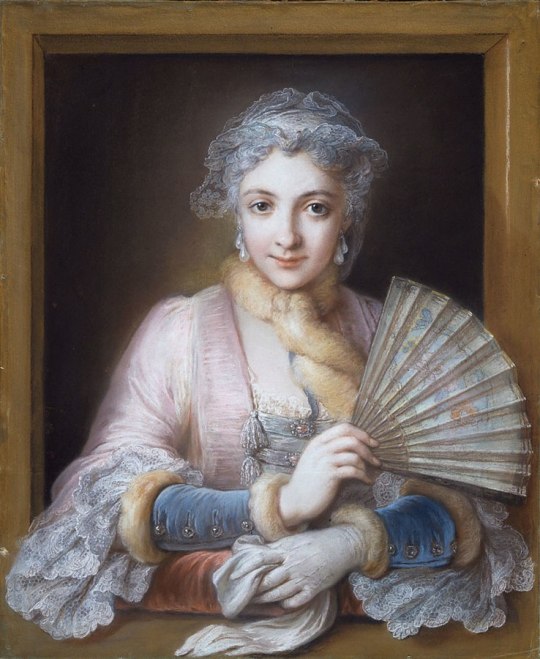
Charles-Antoine Coypel (1694-1752), Portrait of Charlotte Philippine de Châtre du Cangé, Marquise de Lamure (1713-1789) (wrongly identified as Louise Anne de Bourbon, Mademoiselle de Charolais (1695-1758)), 1732-35, pastel on blue paper laid down on linen, 73 x 59 cm, Worcester Art Museum, Worcester (Massachusetts)
Source: Wikimedia Commons
#painting#portrait#female portrait#charles-antoine coypel#18th century#1730s#pastel portrait#pastel#pastel drawing#18th century portrait#18th century fashion#rococo#french rococo#rococo portrait#rococo fashion#historical fashion
9 notes
·
View notes
Photo

Marie Anne de Bourbon (16 October 1697 – 11 August 1741) was Surintendante de la Maison de la Reine to the French queen Marie Leszczyńska. She was the daughter of Louis III, Prince of Condé. Her father was the grandson of le Grand Condé and her mother, Louise Françoise de Bourbon, Mademoiselle de Nantes, was the eldest surviving daughter of Louis XIV of France and his maîtresse-en-titre, Madame de Montespan. She was known as Mademoiselle de Clermont.
20 notes
·
View notes
Text

Louise Anne de Bourbon, Mademoiselle de Charolais (1695-1758) dressed as a monk by Natoire.
2 notes
·
View notes
Text
THIS DAY IN GAY HISTORY
based on: The White Crane Institute's 'Gay Wisdom', Gay Birthdays, Gay For Today, Famous GLBT, glbt-Gay Encylopedia, Today in Gay History, Wikipedia, and more


1644 – The Abbé de Choisy, also known as François Timoléon (d.1724), born in Paris, among the notable Frenchmen of the seventeenth century, has left for posterity a vivid firsthand description of a strong cross-gender wish. During his infancy and early youth, his mother had attired him completely as a girl. At eighteen this practice continued and his waist was then "encircled with tight-fitting corsets which made his loins, hips, and bust more prominent." As an adult, for five months he played comedy as a girl and reported: "Everybody was deceived; I had [male] lovers to whom I granted small favors."

de Choisy as a woman
In 1676, he attended the Papal inaugural ball in a female attire. In 1687, he was received into the Académie de France. In 1696 he became the Ambassador of Louis XIV to Siam.
Regarding his gender identity he wrote,
I thought myself really and truly a woman. I have tried to find out how such a strange pleasure came to me, and I take it to be in this way. It is an attribute of God to be loved and adored, and man - so far as his weak nature will permit - has the same ambition, and it is beauty which creates love, and beauty is generally woman's portion … . I have heard someone near me whisper, "There is a pretty woman," I have felt a pleasure so great that it is beyond all comparison. Ambition, riches, even love cannot equal it …
In 1676, he attended the Papal inaugural ball in a female attire. In 1687, he was received into the Académie de France. In 1696 he became the Ambassador of Louis XIV to Siam.
Regarding his gender identity he wrote,
I thought myself really and truly a woman. I have tried to find out how such a strange pleasure came to me, and I take it to be in this way. It is an attribute of God to be loved and adored, and man - so far as his weak nature will permit - has the same ambition, and it is beauty which creates love, and beauty is generally woman's portion … . I have heard someone near me whisper, "There is a pretty woman," I have felt a pleasure so great that it is beyond all comparison. Ambition, riches, even love cannot equal it …


1667 – Louis de Bourbon, Légitimé de France, Count of Vermandois (d.1683) was the eldest surviving son of Louis XIV of France and his mistress Louise de La Vallière. He was sometimes known as Louis de Vermandois after his title. He died unmarried and without issue.
Louis de Bourbon was born at the Château de Saint-Germain-en-Laye. He was named after his father. Like his elder sister, Marie Anne de Bourbon, who was known at court as Mademoiselle de Blois, he was given the surname of de Bourbon not de France as a result of his illegitimacy. As a child, he called his mother Belle Maman because of her beauty. Louis was legitimised in 1669, at the age of two, and was given the title of comte de Vermandois and was made an Admiral of France.
In 1674, his mother entered a Carmelite convent in Paris, and took the name Sœur Louise de la Miséricorde. Afterwards, they saw very little of each other. From his mother and his father, Louis had five full siblings, many of whom died before his birth.
After his mother left, Louis lived at the Palais Royal in Paris with his uncle, Philippe of France, duc d'Orléans, and his wife Elizabeth Charlotte of the Palatinate. At the Palais-Royal, he became very close to his aunt despite her well-known dislike of Louis XIV's bastards. The affection the aunt and nephew had for each other never diminished.
While he was at the court of his libertine and homosexual uncle, he met the Chevalier de Lorraine, his uncle's most famous lover. It is said that the young count was seduced by the older chevalier and his set (including the Prince of Conti) and began practicing le vice italien (the contemporary appellation for homosexuality).
Louis XIV decided to exile his son and the Chevalier de Lorraine.
In order to cover up the scandal, it was suggested that the boy be married off as soon as possible; a bride suggested was Anne Louise Bénédicte de Bourbon; Louis was exiled before anything could materialise.
In June 1682, Louis was exiled to Normandy. In order to smooth things over between father and son, his aunt Elizabeth Charlotte of the Palatinate suggested to the king that Louis be sent as a soldier to Flanders, which was then under French occupation. The king agreed with the suggestion and his son was sent to the Siege of Courtray. It was there that Louis fell ill.
Despite his illness, Louis was desperate to regain his father's love and continued to fight in battle regardless of advice given by the royal doctor and the marquis de Montchevreuil that he return to Lille in order to recuperate.
Louis died on 18 November 1683, at the age of sixteen. He was buried at the cathedral at Arras. His loving sister and aunt were greatly impacted by his death. His father, however, did not even shed a tear. His mother, still obsessed with the sin of her previous affair with the king, said upon hearing of her son's death: I ought to weep for his birth far more than his death.
Louis was later suspected of being the Man in the Iron Mask.


Gandhi and Kallenbach
1869 – Mohandras Mahatma Gandhi was an Indian lawyer, anti-colonial nationalist, and political ethicist, who employed nonviolent resistance (satyagraha) to lead the successful campaign for India's independence from British rule, and in turn inspired movements for civil rights and freedom across the world. The honorific Mahatma ("great-souled", "venerable"), first applied to him in 1914 in South Africa, is now used throughout the world.
Born and raised in a Hindu family in coastal Gujarat, western India, Gandhi trained in law at the Inner Temple, London, and was called to the bar at age 22 in June 1891. After two uncertain years in India, where he was unable to start a successful law practice, he moved to South Africa in 1893 to represent an Indian merchant in a lawsuit. He went on to stay for 21 years.
It was in South Africa that Gandhi raised a family, and first employed nonviolent resistance in a campaign for civil rights. In 1915, aged 45, he returned to India. He set about organising peasants, farmers, and urban laborers to protest against excessive land-tax and discrimination. Assuming leadership of the Indian National Congress in 1921, Gandhi led nationwide campaigns for easing poverty, expanding women's rights, building religious and ethnic amity, ending untouchability, and above all for achieving Swaraj or self-rule.
Was Mahatma Gandhi gay? A Pulitzer-Prize winning author Joseph Lelyveld claims the god-like Indian figure not only left his wife for a man, but also harbored racist attitudes.
According to Lelyveld, his lover was Hermann Kallenbach, a German-Jewish architect and bodybuilder. The couple built their love nest during Gandhi's time in South Africa where he arrived as a 23-year-old law clerk in 1893 and lived for 21 years.
At the age of 13 Gandhi had been married to 14-year-old Kasturbai Makhanji, but after four children together they broke up so he could be with Kallenbach. As late as 1933 Gandhi wrote a letter telling of his unending desire and branding his ex-wife "the most venomous woman I have met." Kallenabach emigrated from East Prussia to South Africa where he first met Gandhi. The author describes Gandhi's relationship with the man as, "the most intimate, also ambiguous relationship of [Gandhi's] lifetime."
Much of the intimacy between the two is revealed in Kallenbach's letters to his Indian friend after Gandhi left his wifen 'Ba' — an arranged marriage — in 1908 for Kallenbach, a lifelong bachelor, according to the book.
The source of much of the detail of their affair was found in the "loving and charming love notes" that Gandhi wrote to Kallenbach, whose family saved them after the architect's death. They eventually landed in the National Archives of India. Gandhi had destroyed all those from Kallenbach.
It was known that Gandhi was preoccupied with physiology, and even though he had a "taut torso," weighing 106 to 118 pounds throughout his life, the author says Gandhi was attracted to Kallenbach's strongman build.
In letters, Gandhi wrote to Kallenbach, "How completely you have taken possession of my body. This is slavery with a vengeance."
"Your portrait (the only one) stands on my mantelpiece in the bedroom," he writes. "The mantelpiece is opposite the bed."
The pair lived together for two years in a house Kallenbach built in South Africa and pledged to give one another "more love, and yet more love."
Gandhi implored Kallenbach not to "look lustfully upon any woman" and cautioned, "I cannot imagine a thing as ugly as the intercourse of men and women."
By the time Gandhi left South Africa in 1914, Kallenbach was not allowed to accompany him because of World War I. But Gandhi told him, "You will always be you and you alone to me…I have told you you will have to desert me and not I you."
Kallenbach died in 1945 and Gandhi was assassinated in 1948


1985 - Rock Hudson, American actor died (b.1925); Hudson's death from HIV/AIDS changed the face of AIDS in the United States.


1997 – "Variety" objected to the Motion Picture Association of America's decision to give the movie "Bent" an NC-17 rating, pointing out that the sex scenes were far less graphic than heterosexual sex scenes in movies which receive R ratings.


2 notes
·
View notes
Text
Anne de Beaujeu
Anne de Beaujeu (Anne de France, 1461-1522)
Unofficial regent of France and duchess of Bourbon

Anne de Beaujeu provides an example of female political authority in a country where the Salic Law prevented women from assuming the crown. She also illustrates the tension between an increasingly centralized monarchy on the one hand and feudal independence on the other, having supported both causes at different times in her life. Probably born in 1461, Anne de Beaujeu was the oldest of the surviving children of Louis XI, king of France, and the one said to resemble him most intellectually and temperamentally. When this king died in 1483 leaving a thirteen-year-old Charles VIII on the throne, Anne and her husband, Pierre de Beaujeu, as his guardians, assumed control. In so doing, they resisted Louis d'Orléans, the next in line to the throne, who wished to be named regent. Louis and his supporters sought help from the estates-general who met in 1484 but who ultimately supported Anne's cause. Referred to as Madame la Grande (Grand Madam), Anne was recognized by the court and by foreign emissaries as the person actually ruling France during the early years of Charles's reign.
In 1488 she and Charles VIII squelched a noble uprising, the Guerre Folle (the Foolish War) led by Louis d'Orléans and Francis II duke of Brittany. Charles then married the new duchess of Brittany, Anne, to ensure the duchy's loyalty to France. Meanwhile Pierre de Beaujeu's two older brothers had died, leaving Pierre with the Bourbon inheritance. Anne and her husband were now the richest and most powerful nobles in France. In 1491, after the loss of one infant and fifteen years of childlessness, Anne gave birth to a daughter, Suzanne. As Charles VIII grew increasingly independent of his older sister, Anne redirected her attention to her own lands and feudal duties, though she remained his advisor while retaining her ties to the court. When Charles died suddenly in 1498 leaving no heirs, Louis d'Orléans became king of France. Neither his previous attacks on the crown nor his well-known personal vices inspired confidence in his subjects, so the support of Anne de Beaujeu and her husband were instrumental in a smooth accession to the throne. Anne agreed to overlook their antagonistic past and did not hinder the annulment Louis immediately requested from her physically disabled sister, Jeanne. In exchange, Louis XII waived the royal rights to the Bourbon inheritance in the case that Anne and Pierre did not have a male heir. Once all this had been established, the Bourbon's relationship with Louis XII and his new queen, Charles's widow Anne de Bretagne, became quite cordial. Anne de Beaujeu no longer held any direct influence, however, over the governance of the French state.
In 1504 or 1505, after the death of her husband and before she arranged a marriage for her daughter, Anne wrote Suzanne a book of lessons, Les Enseignements d'Anne de France, duchesse de Bourbonnois et d'Auvergne, à sa fille Susanne de Bourbon, modeled on the book that Louis IX had written for his daughter, the one her own father had written for Charles, and the writings of Christine de Pizan. Anne's version contains conventional advice on the appropriate behavior for noblewomen. During her unofficial regency, Anne had overseen the education of many young noblewomen at court, including Louise de Savoie, Marguerite d'Autriche, and Diane de Poitiers. The humble feminine figure that emerges from the Enseignements, however, seems at odds with their independent author. More easily recognizable are the anxieties about life as an older widow distant from court. The Enseignements ends with a tale about a noblewoman who bravely sacrifices her only child for the honor of her family and the interests of the king. Suzanne was, in fact, married shortly thereafter to a cousin to protect the integrity of the Bourbon inheritance.
In contrast to the moral of her tale, however, the interests of a noble family and those of the crown did not always overlap. Before she died, Anne witnessed the opposition of two adults whom she had raised from childhood: her son-in-law, the connétable de Bourbon, and Louise de Savoie, mother of Francis I, successor to Louis XII. Louise and her son, suspicious of the wealth and power of the connétable, the Bourbon heir, challenged his inheritance. After losing the domain that Anne had so carefully built up and defended during her lifetime, the connétable, perhaps with Anne's bitter approval, responded by betraying the French king Francis I- the other cause that Anne had defended so staunchly during her brother's reign. Anne died in 1522, before this ultimate betrayal.
Emily Thompson in Encyclopedia of Women in the Renaissance.
#xv#xvi#anne de france#anne de beaujeu#regents#duchesse de bourbon#louis xi#charles viii#pierre de beaujeu#louis xii#françois ii de bretagne#anne de bretagne#la guerre folle#suzanne de bourbon#sainte jeanne de france#louise de savoie#marguerite d'autriche#diane de poitiers#charles iii de bourbon#le connétable de bourbon#françois i#proof that anne approved of this ? i didn't find anything#the connétable's betrayal is a complex story#one can point fingers at françois i and louise de savoie too#emily thompson#encyclopedia of women in the renaissance
17 notes
·
View notes
Text

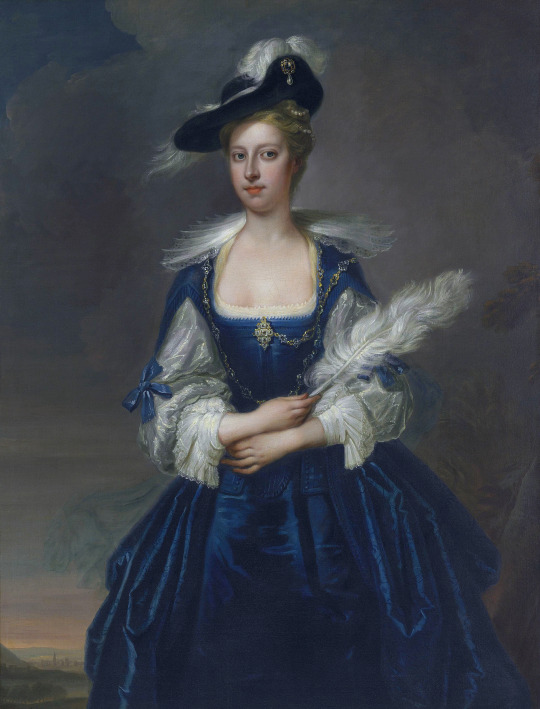
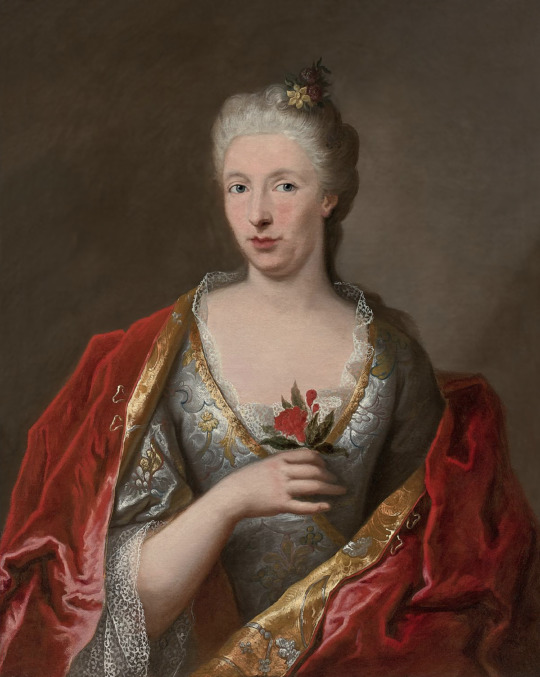
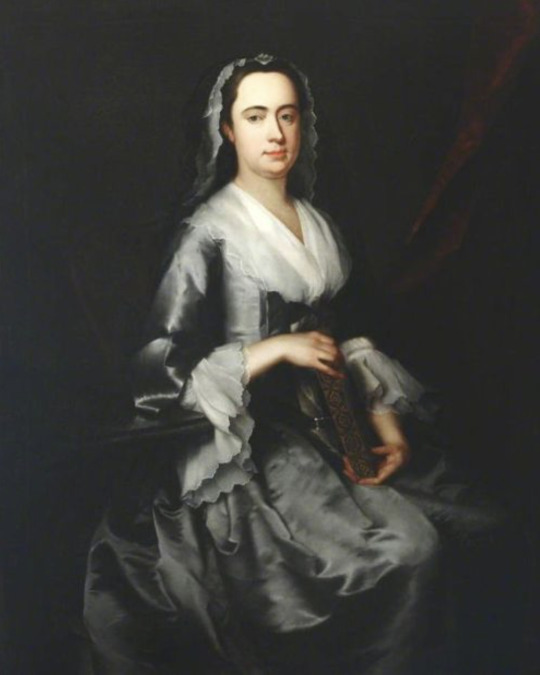
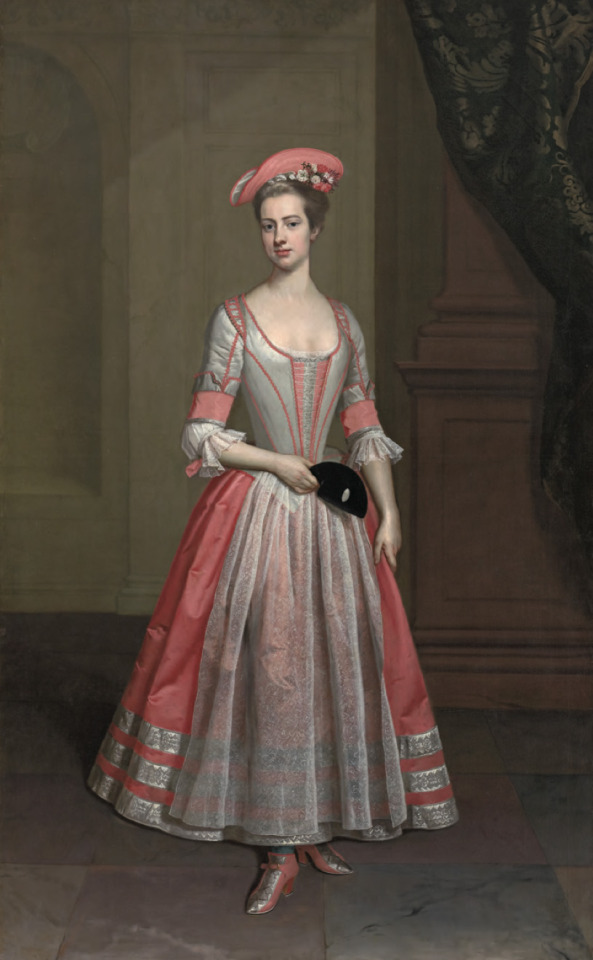
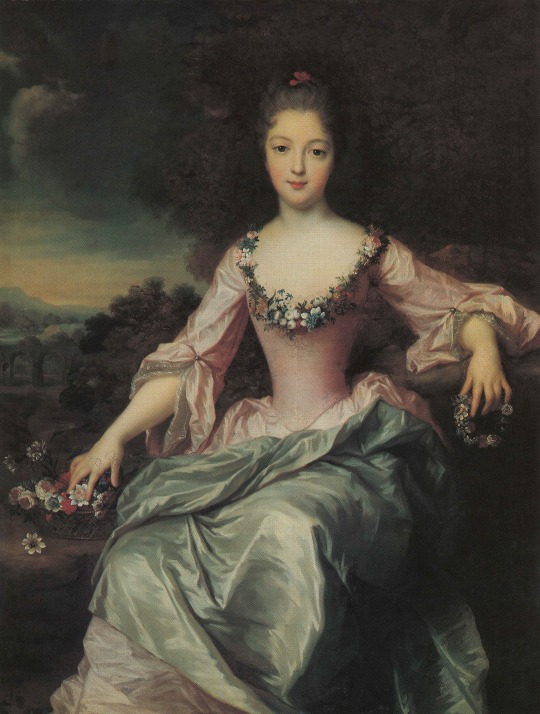

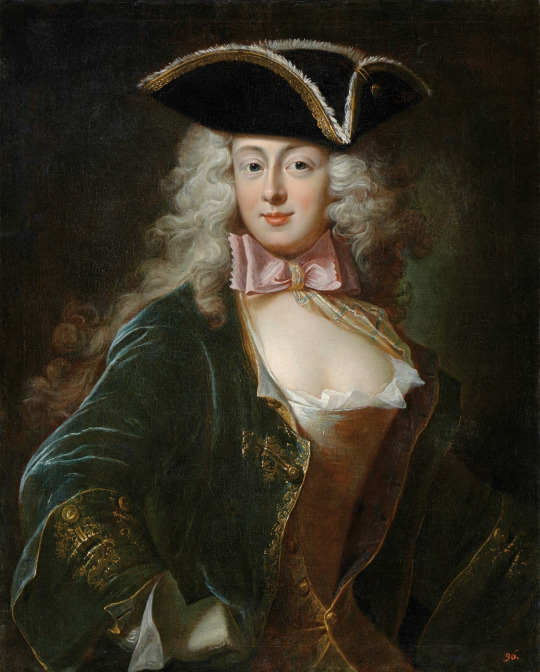

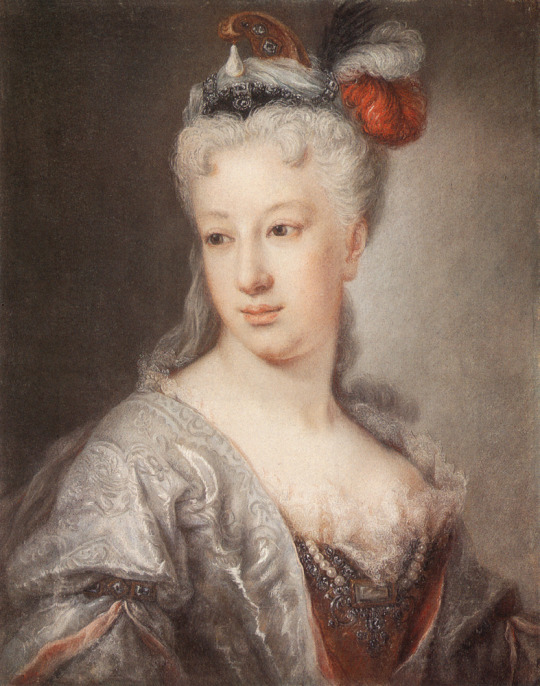

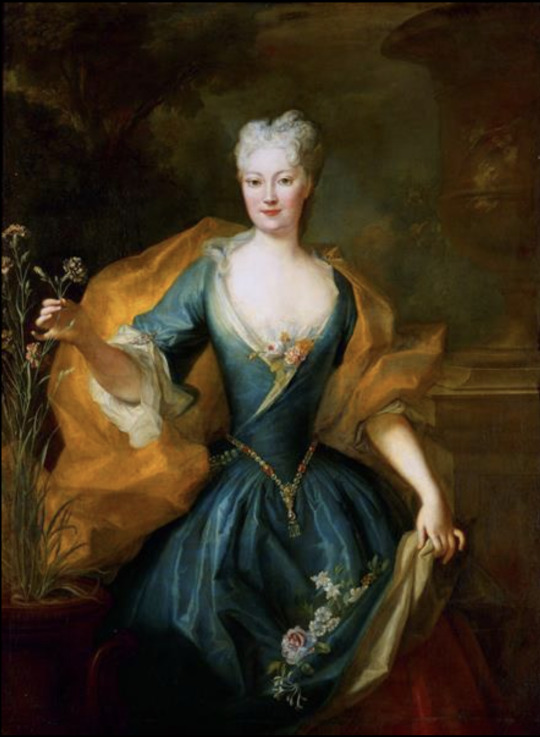

1720s dress -
Top left 1720 (probably) Princess Rakoczi by Nicolas de Largillierre (National Gallery - London, UK); From paintings-art-picture.com/paintings/archives/534/largilliere-nicolas-de-princess-rakoczi; removed spots throughout image and print in lower rt corner 152.0X2000.
Top right ca. 1720 (based on date of marriage) Elizabeth Dunch, later Lady Oxenden, by Thomas Hudson (auctioned by Christie’s). From their Web site; fixed obvious spots w Pshop 2449X3215.
Second row left ca. 1720 Dame dite madame Élisabeth Parisot by entourage of Jean-Baptiste Oudry (on auction by Tajan). From invaluable.com-auction-lot-ecole-francaise-vers-1720-entourage-de-jean-bapti-42-c-20e48bc868; fixed creases w Pshop 2990X3747.
Second row right ca. 1720 Mrs or Miss Mary Miller by the circle of Jonathan Richardson the elder (location ?). From titam.tumblr.com 1228X1536.
Third row ca. 1720 Henrietta Hobart, The Hon. Mrs Howard, later Countess of Suffolk, in a masquerade dress attributed to Thomas Gibson (Blickling Hall - Blickling, Norfolk, UK). From the National Trust's Blickling Hall Illustrated Picture List 816X1321.
Fourth row 1720 Marie Anne de Bourbon Condé by Gustaf Lundberg (auctioned by Nordén Auktioner). Probably from their Web site 3871X5117.
Fifth row 1721 Louise Anne de Bourbon, Mademoiselle de Charolais by Charles Antoine Coypel (location ?). From jeannedepompadour.blogspot.com/2012/03 820X1000.
Sixth rów left 1722 (before) Emerencjanna Pociej née Warszycka by Ádám Mányoki (Pałac Łazienkowski - Warszawa, Poland). From Wikimedia; too many flaws to fix 1608X2000.
Sixth row right 1722 Élisabeth-Charlotte d'Orléans, duchesse de Lorraine, avec son second fils François-Étienne par Alexis Simon Belle (location ?) From www.altesses.eu/princes290.php 823X1188.
Seventh row 1722 Marchesa Maria Guicciardini, née Rinuccini by Giovanna Fratellini (Galleria degli Uffizi - Firenze, Toscana, Italy). From www.pastellists.com; fixed left half of upper edge with Photoshop 787X1000.
Eighth row left 1723 Liselotte von der Pfalz by Hyacinthe Rigaud (auctioned by Tajan). Posted to Foro Dinastias by Minnie on 7 February 2010; removed flaws in background with Photoshop 614X1024.
Eighth row right 1724 Countess Karoline Friederike Lubomirska by Louis de Silvestre (private collection). From the-athenaeum.org 1768X2414.
Ninth row 1724 The Garter by Jean-François de Troy (location ?). From tumblr.com/catherinedefrance fixed obvious spots w Pshop 662X800.
#Princess Rakoczi#sucrcote#V waistline#Nicolas de Largillierre#1720s fashion#Rococo fashion#Louis XV fashion#Georgian fashion#Elizabeth Dunch#Thomas Hudson#ruff#Élisabeth Parisot#Jean-Baptiste Oudry#cross over bodice#Mary Miller#Jonathan Richardson the Elder#fichu#Henrietta Hobart#Thomas Gibson#apron#Marie Anne de Bourbon Condé#Gustaf Lundberg#Basque neckline#notched sleeves#Louise Anne de Bourbon#Charles Antoine Coypel#cap#fan#lace enggageantes#Emerencjanna Pociej
16 notes
·
View notes
Text






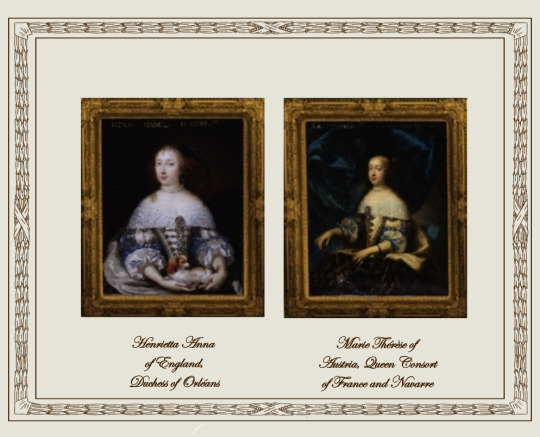
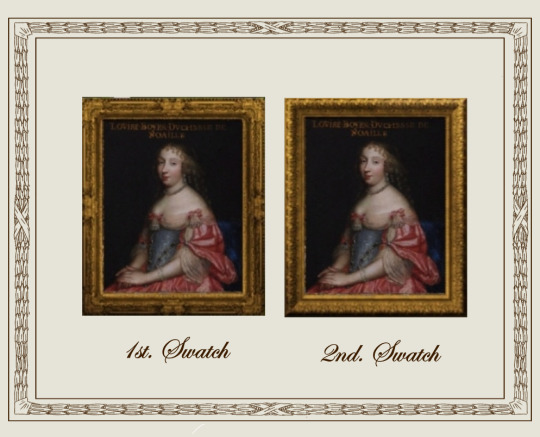
Louis XIV's Gallery of Beauties
A retexture by La Comtesse Zouboff — Original Mesh by @thejim07
This set of 20 portraits was comissioned by the king himself in the 1650s to Charles and Henri Beaubrun (except for a portrait of Henrietta Anna of England, Comissioned to Nicolas Mignard) The portraits comprises the queen, royal princesses and ladies of the court. They hanged at the king's appartments at Versailles. In the 1670s the paintings were progressively relegated to the king's minor residences, but in 1837, Louis-Philippe, King of the French turned Versailles into a museum and rejoined the paintings, in the Louis XIV Rooms, where they remain.
The set includes 20 portraits, with the original frame swatches, fully recolorable. The portraits are of:
Anne Genèvieve de Bourbon, Duchess d'Estouteville and Longueville
Françoise-Athénaïs de Rochechouart (later, Marquise de Montespan)
Anna Martonozzi, Princess of Conti
Anne Louise Boyer, Duchess of Noailles
Anne Marie Gonzaga, Countess Palatine
Anne de Rohan-Chabot, Princess de Soubise
Catherine Henriette d'Harcourt, Duchess d'Arpajon
Catherine de Neuville, Countess d'Armagnac
Charlotte Catherine de Gramont, Proncess of Monaco
Charlotte Isabelle Angélique de Montmorency-Bouteville, Duchess of Mecklenburg-Schwerin
Elizabeth of Orléans, Duchess of Guise and Joÿeuse
Françoise Madeleine d'Orléans (née de Valois) Duchess of Savoy
Françoise Mignot, Mareschalle of l'Hospital
Françoise de Neufville, Duchess of Chaulnes
Gabrielle-Louise de Saint-Simon, Duchess of Brissac
Henrietta Anna of England, Duchess of Orléans
Madeleine-Charlotte d'Albert-d'Ailly, Duchess of Foix
Marguerite Louise d'Orléans, Grand Duchess of Tuscany
Marguerite-Louise-Suzanne de Béthune-Sully, Countess of Gyche
Marie Thérèse of Austria, Queen Consort of France and Navarre
Found under Decor > Paintings for 940 §
Retextured from the "portrait of Anne Marie Louise d'Orléans", found here
Table, torcheres and floor by @thejim07
Rest of the decor by @joojconverts
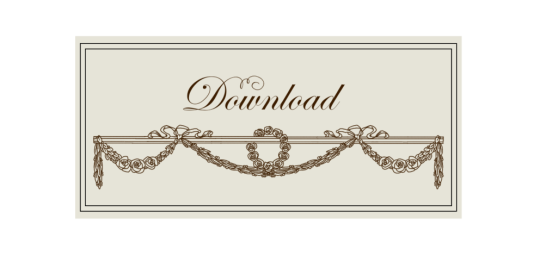
Drive
(Sims3pack | package)
(Useful tags)
@joojconverts @ts3history @ts3historicalccfinds @deniisu-sims @katsujiiccfinds
-------------------------------------------------------
#the sims 3#ts3#sims 3 cc#portrait#s3cc#sims 3#sims 3 download#sims 3 cc finds#palace of versailles#sims 3 decor#wall decor
41 notes
·
View notes
Text

Marie Anne de Bourbon, Princess of Conti. She was the daughter of Louis XIV and Louise de La Vallière, and was legitimized at seven months old.
#Louise de La Vallière#marie anne de bourbon#louis xiv#french monarchy#17th century art#17th century#long live the queue
74 notes
·
View notes